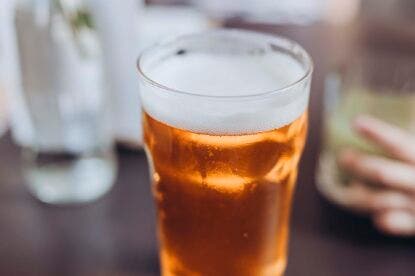Since its beginnings in the late 1970s, the American craft beer movement has exalted India pale ales (IPAs). They’ve gone through several incarnations, from those made with floral, earthy hops and a backbone of toasted malt, to a hops arms race to see which producer could make the most bitter IPA. But in this ever-changing world, the latest palate-shifting ales illustrate a move in a different direction. Meet the brut IPA.
Similar to the Champagne style from which it gets its name, brut IPAs are straw-colored in appearance, bone-dry and refreshingly effervescent. The secret ingredient for their perfect dryness? The amylase enzyme, which, when added after fermentation, converts residual sugars into fermentable sugars and yields a lighter body and reduced sweetness in high-alcohol beers.
“We really enjoy dry white wine in general, and admire the similarities between some white wines and IPAs, in both aromatics and flavor. So, we decided to blur the lines a bit.” —Adam Cieslak, co-founder/head brewer, Maplewood Brewery & Distillery
Kim Sturdavant, brewmaster at San Francisco’s Social Kitchen & Brewery, is credited widely as the style’s inventor.
“The inspiration for the beer came from using the enzyme in my triple IPA to get that beer as dry as possible because that is normally a very perceivably sweet style,” says Sturdavant.

His experiment worked. And while it was conceived in Northern California, seen by many as the cradle of American craft beer, breweries nationwide are now making this dry delight.
Adam Smith, special projects lead brewer/brand manager of Chicago’s Maplewood Brewery & Distillery, and Adam Cieslak, co-founder/head brewer , were prompted by their love of dry white wine to create their Mega Dry brut IPA. “We really enjoy dry white wine in general, and admire the similarities between some white wines and IPAs, in both aromatics and flavor,” says Cieslak. “So, we decided to blur the lines a bit.”
Their brut recipe is constantly evolving.

“With our first batch, we tried to mimic the gooseberry and grapefruit notes often found in a New Zealand Sauvignon Blanc,” says Smith. “With the second batch, we used a French Champagne yeast and hops selected to mimic a true brut Champagne.
“With our third upcoming batch, we’ll follow that same process—finding a dry white wine we enjoy and trying to capture those notes and characteristics and get them into a beer.”
The name Blanc Stare came from a mutual look of astonishment that [head brewer Joel] Kodner and his assistant gave each other after they sampled the finished beer.
Kevin Blodger, co-founder/director of brewing operations for Union Craft Brewing in Baltimore, was intrigued when he heard about the brut IPA. He didn’t know where to start, but then he caught a lucky break.
“Prior to brewing a brut IPA, I had never had one,” says Blodger. “So I did a ton of research because I wanted to know everything about it [that] I could.”

He stumbled upon a video where Sturdavant discussed the brut IPA. From there, Blodger brought his vision to life as part of Union’s Rough Draughts series of experimental, small-batch beers. Starting with Sturdavant’s blueprint, Blodger added his own distinctive touch.
“I used Nelson [Sauvin] and Hallertau Blanc because I wanted the hops to be fruit-forward and flavorful,” he says.
“I started thinking about how we could create a sparkling version of a Sancerre [rosé], I knew it would have to be a kettle-soured beer. And then I read a bit about Kim Sturdavant’s brut IPA and how he was able to achieve the dryness.” —Joe Ploof, founder/CRO, Hanging Hills Brewing Company
The brut style isn’t just limited to IPAs. Head brewer Joel Kodner, of Florida’s West Palm Beach Brewery & Wine Vault, was eager to try his hand at a brut brew, but first applied the process to a French-style saison to create his Blanc Stare brut offering.

“I figured a super-dry saison could be a good guinea pig for tinkering with the enzyme,” says Kodner. “Once it was finished, we conservatively dry-hopped it with Hallertau Blanc to maintain the saison character, but still impart that terrific white grape and subtle tropical note you can get from those hops.”
The name Blanc Stare came from a mutual look of astonishment that Kodner and his assistant gave each other after they sampled the finished beer.

In Hartford, Connecticut, Hanging Hills Brewing Company’s version of the brut-style beer took a more colorful approach. Its Lucada brut rosé ale is made with pomegranate and hibiscus.
“We wanted to create a non-IPA beer that was both elegant and unique with a low [alcohol content],” says Joe Ploof, founder/CRO of Hanging Hills.
A huge wine fan, Ploof was inspired by the delicate and balanced acidity of French rosés.

“I started thinking about how we could create a sparkling version of a Sancerre [rosé],” he says. “I knew it would have to be a kettle-soured beer. And then I read a bit about Kim Sturdavant’s brut IPA and how he was able to achieve the dryness.
“We figured the dryness created by the enzyme would emphasize not only the pomegranate and hibiscus, but also the tartness of the beer.”
It’s that complementary aspect that makes brut beers so appealing. As an option for both wine-loving beer-drinkers and beer-drinking wine lovers, the style has broad appeal. Its versatility and crispness are likely to continue winning over new fans.
Last Updated: May 22, 2023















